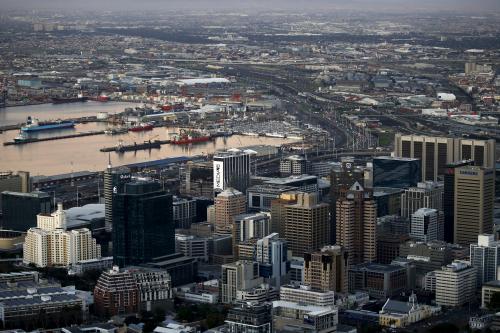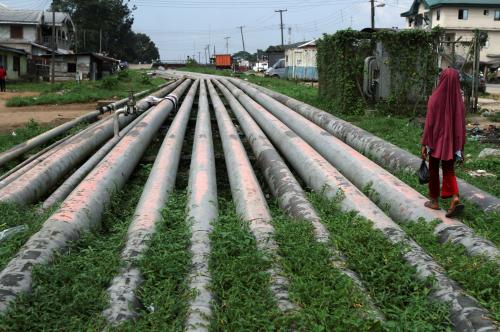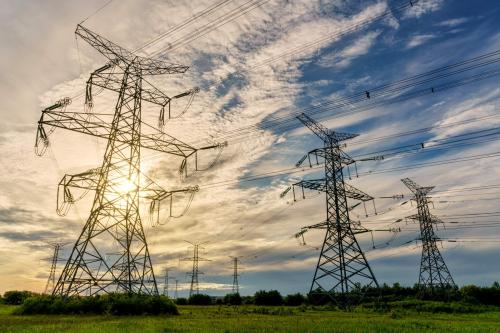Can governments in resource-rich countries manage and coordinate incoming investment in ways that spur and sustain economic growth? This question has motivated and perplexed development policymakers and scholars for decades. The conventional wisdom is that natural resource sector foreign direct investments (FDI) usually lead to territorial enclaves with foreign workers who import goods, repatriate profits, and build few linkages to the local economy. Cross-country empirical studies demonstrate that extractive sector investment is associated with low growth, no growth, or even negative growth outcomes.
But policy experimentation is on the rise among governments in resource-rich countries that have historically attracted large inflows of extractive sector FDI but not experienced large economic growth gains. One increasingly popular government strategy is to require that foreign companies provide public goods—for example, by building and rehabilitating roads, power plants, and health and education systems—in or near the communities where their natural resource sector investments are physically sited. These types of spatial development corridor strategies are usually based on the idea that concentrating and co-locating infrastructural investments in specific geographic areas (where natural resource sector FDI activities will also be sited) will create clusters of interconnected firms, nurture the development of value chains, and set in motion economic agglomeration processes.
Liberia is one of several countries in sub-Saharan Africa pursuing such a strategy. Since 2006, the Ellen Johnson-Sirleaf administration has made natural resource sector FDI the centerpiece of its growth and development strategy. It has granted hundreds of natural resource concessions to foreign investors, which allow them to extract and export iron ore, gold, palm oil, rubber, and other natural resources. But it has stipulated in its contracts with foreign concessionaires that they must build and maintain public infrastructure, including roads, railways, bridges, ports, and power plants.
The Johnson-Sirleaf administration has also prioritized investments in three specific geographic areas (see Figure 1) near population centers and existing markets where it sees the greatest potential to establish new spatial development corridors that will nurture the growth of small- and medium-sized enterprises, reduce unemployment, and deliver essential public services to firms and households. The goal is to maximize the economic multiplier effects that can be generated by infrastructure financed and supplied by concessionaires—in particular, mining concessions.
Figure 1: The Ellen Johnson-Sirleaf Administration’s Development Corridor Priorities
 Source: Government of Liberia, 2010. This map was provided by Dr. Lucie Phillips of IBI International. It is republished it with permission from Liberia’s Ministry of Planning and Economic Affairs, accessed via AidData
Source: Government of Liberia, 2010. This map was provided by Dr. Lucie Phillips of IBI International. It is republished it with permission from Liberia’s Ministry of Planning and Economic Affairs, accessed via AidData
Note: One corridor runs from the iron ore mines in Nimba County to the port city of Buchanan; a second runs from Monrovia to Tubmanburg and then to the gold and iron ore deposits in Bomi Hills, Bea Mountain, and Mano River; and a third runs from the Putu Range in Grand Gedeh county to Greenville. The Government of Liberia also identified a fourth potential development corridor that could run north from Monrovia to the Wologizi deposit (see Figure 1). However, given that this deposit had “not yet been proven economically viable” at the time the authorities drafted their strategy, it was not assigned a high level of priority. See Government of Liberia. 2010. Liberia’s Vision for Accelerating Economic Growth: A Development Corridor Desk Study. Monrovia, Liberia: Ministry of Planning and Economic Affairs.
In partnership with the International Growth Center and Humanity United, my colleagues and I recently completed a geospatial impact evaluation to determine whether this investment management and coordination strategy is working. To do so, we first assembled a dataset of all natural resource concessions granted to investors in Liberia from 2004 to 2015. We also constructed polygons that correspond to the specific tracts of land granted to investors (see Figure 2), which made it possible to calculate at a high-level of spatial resolution if particular locations had been “treated” with FDI activity. We then merged these geocoded investment data with a remotely sensed outcome measure of nighttime light growth at the 1 square kilometer grid cell level.
Figure 2: Natural Resource Concessions in Liberia, 2007-2013

Source: AidData
To establish a credible counterfactual, we used data from satellite imagery, weather stations, household surveys, and administrative records and propensity score matching methods to identify pairs of treated and untreated locations that were equally likely to receive natural resource sector FDI. We then calculated the difference between nighttime light growth (between 2006 and 2013) in the treatment group and the control group.
Here’s what we found:
- Natural resource concessions improve local economic growth outcomes. On average, natural resource concessions increase nighttime light by 0.58 percent in the 25 kilometer surrounding concession areas, which roughly corresponds to a 0.17 percenbt increase in local GDP.
- Mining concessions have a positive effect on local economic growth outcomes. By contrast, there is no robust evidence that agricultural concessions register consistent effects on local economic growth outcomes.
- Corporate social responsibility (CSR) projects do not have detectable effects on local economic growth outcomes. We found no evidence that concessions with CSR provisions economically outperform concessions without CSR provisions.
- U.S. concessions do not have any discernible effect on local economic growth, while Chinese concessions do. Chinese mining investments increase nighttime light output by 1.26% in the 20 kilometer surrounding their concession areas, which is roughly equivalent to a 0.38% increase in local GDP
These results suggest that targeting and co-locating FDI projects and public goods investments in specific geographic areas can indeed set in motion local economic agglomeration processes. It is particularly notable that the natural resource concessions which were subject to more demanding public good provision requirements (i.e., mining investment projects) produced higher levels of local economic growth than those that faced less demanding public good provision requirements (i.e., agricultural investment projects). Also, the fact that Chinese investors, who have generally been more willing and able to satisfy the Johnson-Sirleaf administration’s public good requirements than U.S. investors, are delivering stronger economic growth impacts is consistent with the theory of change underpinning the government’s spatial development corridor strategy.
These findings speak to an ongoing debate among Liberian policymakers, media, and domestic civil society groups about the types of concessions and concessionaires that deliver the largest economic development dividends. They also suggest that the conventional wisdom about the growth effects of natural resource sector investment is insufficiently nuanced. While natural resource sector investments may be associated with low growth, no growth, or even negative growth outcomes, policy choices still matter. When governments require investors in the extractives sector to provide public infrastructure, they can achieve significant economic multiplier effects. This is apparently true even in fragile states where one might not expect the implementation of a government-led investment management and coordination strategy to succeed.
An interactive web portal with the subnationally georeferenced investment and outcome data is available at aiddata.org/liberia-concessions.







Commentary
Getting better development returns on investment in the natural resource sector
March 6, 2017